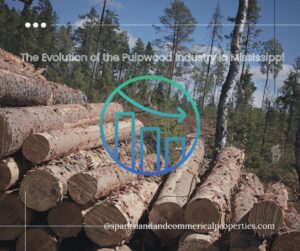The Evolution of the Pulpwood Industry in Mississippi and Prices

Mississippi, endowed with abundant fertile forests, holds a significant place in America’s pulpwood industry. The industry has witnessed a roller-coaster ride of stumpage and pulpwood prices over the years. The mid-20th century saw a surge in the pulpwood industry in Mississippi due to the construction of numerous pulp and paper mills, leading to increased pulpwood demand. However, the advent of the 21st century brought along technological advancements and imported pulpwood, unsettling the market, causing price fluctuations for stumpage and pulpwood per ton. Lets discuss what these terms mean.
When we talk about a ‘cord’, it refers to a specific forestry measurement which equals a stack of wood 4 feet high, 4 feet wide, and 8 feet long, often used for firewood. ‘Price per ton’ reflects the cost per ton of pulpwood, a type of timber primarily used for paper manufacturing. Factors such as the timber’s quality, tree species, demand, and accessibility significantly influence the price per ton of pulpwood.
Now, let’s get into some calculations. Imagine you have a 100-acre forest that generates 3.2 tons of timber per acre each year, of which 37.5% is pulpwood. Therefore, each acre produces 1.2 tons of pulpwood annually (3.2 tons x 37.5%). Over your entire 100-acre forest, that amounts to 120 tons of pulpwood each year (1.2 tons per acre x 100 acres).
If the stumpage price, which is the amount a landowner is paid for standing timber, is $2.00 per ton, then the total value of your pulpwood each year would be $240 (120 tons x $2.00 per ton).
Next, let’s convert this to cords. A cord of wood typically weighs around 2 tons. Therefore, the 120 tons of pulpwood you’re producing each year equates to approximately 60 cords of pulpwood (120 tons ÷ 2 tons per cord). With the stumpage price of $2.00 per ton, each cord is worth approximately $4.00 ($2.00 per ton x 2 tons per cord). So, the total annual value of your pulpwood, if measured in cords, would still be $240 (60 cords x $4.00 per cord).
In conclusion, the value of the pulpwood you can harvest from your 100-acre forest, whether calculated in tons or cords, comes out to be the same at $240 per year at the current stumpage price of $2.00 per ton. This underlines the importance of understanding and correctly using forestry measurements in the timber industry.
Today, in the mid-2020s, the pulpwood industry in Mississippi continues to evolve. The proliferation of digital technology has led to a decline in paper products, thereby reducing pulpwood demand. Despite the diminished demand, Mississippi’s forests continue to produce a substantial amount of pulpwood, leading to an oversupply and putting downward pressure on stumpage and pulpwood prices per ton. The industry is navigating this scenario by exploring new pulpwood applications, such as bioenergy production, particularly in the form of wood pellets for energy.
Despite the challenges, Mississippi’s pulpwood future appears promising due to its potential to leverage its rich forest resources for innovation and adaptability. While traditional pulpwood usage for paper production might be dwindling, burgeoning markets like bioenergy and engineered wood products could open new avenues for growth. Thus, the pulpwood industry in Mississippi is in a constant state of flux, faced with challenges, yet its rich history and potential for innovation and new opportunities.
Factors Influencing Paper-Making Wood Prices in Southern US
Understanding the influence of roundwood pulpwood supply and demand on its pricing is complex, primarily due to the availability of sawmill leftover chips as an alternative. The recent decade’s lumber production surge in the south has increased leftover chip production, helping maintain roundwood pulpwood prices stability. A thorough understanding of pulpwood pricing complexities can help decipher pricing trends.
Between 2015 and 2019, most southern region states experienced relatively minor changes (less than 10%) in pulpwood demand and its pricing. However, Alabama, Arkansas, Mississippi, and North Carolina deviated from this pattern. In these states, prices fell despite a slight drop in demand, or demand outpaced price increases. From 2019 to 2022, pulpwood prices soared by 10% or more in three states, with only Alabama witnessing a corresponding demand increase.
Comparing demand changes with pulpwood price changes from 2019 to 2022 reveals less correlation between price responses and demand changes. Contrarily, many states exhibit a negative relationship with demand. Unlike the more direct relationship between sawlog demand and prices, pulpwood prices are influenced by by factors like leftover chips, demand for oriented strand board, wood pellets, and pulp markets and exports.
Understanding Tree and Lumber Market Mechanisms
The tree and lumber markets operate differently, influenced by distinct pricing trend factors. Trade volumes, supply conditions, and demand factors play pivotal roles. Lumber, a heavily traded product, is highly susceptible to daily events, resulting in frequent, sometimes unpredictable price changes. The tree market is less reactive to daily events, with tree prices being more affected by long-term trends such as forest growth rates, harvesting costs, and overall timber product demand.
By mid-2021, this trend seemed to be shifting. Despite economic uncertainties, the robust housing market required substantial lumber, reflecting high demand in southern sawtimber prices, which peaked to a 14-year high. However, 2022 witnessed a decline, and by 2023, lumber prices bottomed out due to a decrease in new construction. The National Association of Home Builders predicts a decrease in housing starts to approximately 744,000 single-family homes in 2023, as builders continue to cut back despite a housing shortage.
The below chart is a current snapshot of lumber prices USD/1000 Board Ft

Pulpwood prices at end of 2002 below

During a housing boom, the demand for various timber products, including pulpwood, generally increases. This is because a surge in housing construction requires more raw materials, including timber for construction and pulpwood for paper-based products such as wallpaper, insulation, and cardboard used in packaging. When demand increases, it can lead to a rise in pulpwood prices as suppliers try to meet the greater need for their products.
However, the relationship between a housing boom and pulpwood prices isn’t as direct as with other timber products. This is mainly because the primary use of pulpwood is for paper products, not directly for construction. While certain types of timber such as sawlogs are directly used in housebuilding, leading to a more immediate and significant price impact during a housing surge, pulpwood doesn’t experience the same level of price fluctuation. The price of pulpwood is more influenced by the demand for paper products, which can be affected by a variety of factors, including digitalization trends, recycling rates, and global market dynamics.
Despite this, it’s important to note that a housing boom can indirectly affect pulpwood prices. For instance, increased construction activity can lead to a greater need for packaging materials, which are often made from pulpwood. This can result in a modest increase in pulpwood prices, even though the effect may not be as pronounced or immediate as it is for timber directly used in construction. So, while pulpwood prices may see some increase during a housing boom, they are somewhat separate from the direct influence of housing construction compared to other timber products.
Emerging Markets: Bioenergy and Engineered Wood Products
Pulpwood in Mississippi is finding new uses beyond traditional paper production, with its conversion into wood pellets for bioenergy production being one of the most significant. As the world shifts towards renewable energy sources, the demand for biomass in the form of wood pellets is growing, creating a new market for pulpwood growers. Mississippi’s location, near the Gulf of Mexico, provides a logistical advantage for shipping wood pellets to Europe, where the demand for bioenergy is particularly high. This emerging market could potentially counterbalance the declining demand for pulpwood for paper production.
Future Pathways: Forestland Investment and Forest Management
While the forest products market dynamics continuously shift, some trends can guide investors and managers to anticipate market changes.
- Climate Change and Forest Management: Climate change increasingly impacts the forest products market. Changes in weather patterns can affect forest growth rates and pest and disease occurrences, influencing timber production and prices. Additionally, growing interest in forests as carbon sinks could create new markets for forest carbon credits.
- Technological Innovations: Technological breakthroughs in remote sensing and data analysis are revolutionizing forest management. These technologies can enhance forest inventory data, optimize harvest operations, and improve supply chain efficiency, leading to higher profits for forestland owners and managers.
- Shifting Demand Patterns: Demand for forest products can fluctuate due to factors like population growth, economic conditions, and consumer preferences. For instance, there is a rising demand for sustainable and renewable forest products, which can create new opportunities for forestland owners and managers.
- Investment Trends: The timberland investment landscape is also evolving. While institutional investors have historically dominated the timberland investment space, there is growing interest from individual investors and family offices, which could alter timberland investment structures and management.
Resources and Links
- US Forest Service – This federal agency provides a wealth of information on forests and forestry in the United States, including research, statistics, and resources on sustainable forest management. US Forest Service
- Mississippi State University Extension Service – This extension service offers resources and educational programs on forest and wildlife resources in Mississippi. MSU Extension
- National Association of Home Builders – This trade association provides data and forecasts on the housing market in the United States, which can affect demand for lumber and timber products. NAHB
- Timberland Investment Resources, LLC – This company offers information and services related to timberland investment. They also provide a blog that covers various aspects of investing in timberland. Timberland Investment Resources
- The Forest History Society – This organization offers a wide range of resources on the history of forests and forestry, including the evolution of the timber industry and forest management practices. The Forest History Society




